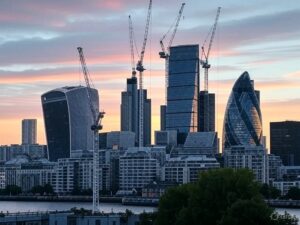London remains a global magnet for property investment, offering resilience and long-term capital appreciation. However, for buy-to-let landlords focused on optimising rental yield and finding genuine growth opportunities, the secret lies in looking beyond the established prime postcodes. In 2025, the city’s investment landscape is defined by dynamic regeneration, improved connectivity, and a shifting demand for affordability, creating exciting new emerging hotspots for savvy investors.
This in-depth guide will reveal London’s top areas poised for significant buy-to-let potential, explaining the drivers behind their growth and how to identify your next profitable investment.

The Shifting Landscape of London Property Investment
While Prime Central London (PCL) may offer prestige and capital preservation, its rental yields typically remain modest (2.5-3.5%) due to high entry prices. For investors prioritising stronger cash flow and future growth, the focus has increasingly shifted to the outer boroughs and areas undergoing significant transformation.
Key Investment Drivers in 2025:
- Regeneration Projects: Large-scale urban renewal initiatives bring new housing, retail, cultural venues, and job opportunities, revitalising areas and driving demand.
- Improved Transport Links: The ongoing “Crossrail effect” continues to unlock previously less accessible areas, significantly cutting commute times to major employment hubs like the City, Canary Wharf, and the West End.
- Affordability & Value: Tenants, especially young professionals and families, are increasingly seeking value further out from the centre, where rents are more sustainable without sacrificing connectivity.
- Strong Rental Demand: Demand continues to outstrip supply in many areas, particularly for one and two-bedroom apartments, and Houses in Multiple Occupation (HMOs).
Top Emerging Buy-to-Let Hotspots in London
Based on current market trends, regeneration pipelines, and rental yield potential, these London areas stand out for property investors:
East London: Yield Powerhouses & Regeneration Frontlines
East London continues to be a powerhouse for rental yields and investment growth, driven by ongoing regeneration and strong tenant demand.
- Barking & Dagenham (IG11, RM10): Consistently offering some of London’s highest yields (6-7%). Significant council-led regeneration, major housing developments, and improved infrastructure (including Elizabeth Line access for Barking) make it highly attractive for families and professionals seeking affordability with good links to the City and Canary Wharf.
- Woolwich (SE18): Transformed by the Elizabeth Line, connecting it directly to central London. The Royal Arsenal Riverside project is a major draw, offering thousands of new homes, shops, cafes, and cultural spaces. It’s attracting a younger demographic and still provides good value compared to neighbouring Greenwich. (Yields around 5.5-6.1%).
- Bow (E3): A Zone 2 gem with quick access to Canary Wharf and Stratford. This area benefits from gentrification, new developments, and proximity to green spaces like Victoria Park, appealing to young professionals priced out of Hackney. (Yields around 6-6.3%).
- East Ham (E6): Often highlighted for its high yields (6-6.5%), East Ham offers a compelling balance of affordability and location within the Newham borough, benefiting from ongoing regeneration.
- Stratford / West Ham (E15): The legacy of the Olympics combined with excellent transport connections (Elizabeth Line, DLR, Overground) continues to drive strong rental demand here. Significant residential and commercial developments are still underway. (Yields around 5.8%).
- Thamesmead (SE28): Emerging as an affordable option in Southeast London, benefiting from proximity to Elizabeth Line stations (Abbey Wood, Woolwich) and ongoing riverside developments. Attracts families seeking more space and green areas. (Yields around 5.9-6.1%).
South East London: Value and Connectivity
Beyond the immediate East London hotspots, other areas in the Southeast offer compelling opportunities.
- Croydon: Positioned as “London’s third city,” Croydon is undergoing massive redevelopment with a strong focus on tech businesses. Excellent transport links to Central London make it highly appealing for commuters. (Yields around 5.0%).
- Peckham (SE15): Shedding its old image, Peckham is now a vibrant cultural hub with a youthful, creative energy. Improving transport links and its unique lifestyle appeal continue to drive property values and rental demand, particularly for millennials and Gen Z.
- Deptford (SE8): With a thriving arts scene and community feel, Deptford offers a more affordable entry point than Greenwich. Regeneration around Deptford Market Yard and Convoys Wharf enhances its appeal, while Overground and rail links keep it well-connected.
West London: The Lasting Crossrail Effect
While the initial “Crossrail effect” saw significant price jumps, opportunities remain in areas still consolidating their benefits.
- Southall (UB1) & Hayes (UB3): These areas have been significantly boosted by the Elizabeth Line, transforming from industrial zones into desirable residential hubs. Improved connectivity to Central London and Heathrow makes them attractive to professionals and families, driving strong rental demand and capital appreciation. (Yields around 6%).
North London: Targeted Growth
- Tottenham (N17): Undergoing substantial regeneration, including new housing, infrastructure, and amenities. Its affordability relative to other North London areas, coupled with improved transport, makes it an area to watch for long-term growth and healthy yields. (Yields around 5.8%).

Identifying Your Next Investment: Key Considerations
Beyond these specific hotspots, successful buy-to-let investment in London hinges on a few fundamental principles:
- Due Diligence: Research specific streets, local amenities, and future development plans. What’s the local school situation? Are there new businesses opening?
- Transport Connectivity: Always a critical factor in London. Proximity to Tube, Overground, DLR, or Elizabeth Line stations is paramount for rental demand.
- Tenant Demographics: Understand who your target tenant is (families, professionals, students) and what type of property and amenities they value in that area.
- Yield vs. Capital Growth: Decide your primary investment goal. High yields are often found in more affordable areas, while prime capital growth areas might have lower initial yields but greater long-term appreciation potential.
- Property Type: HMOs can offer higher yields but come with more complex regulations and management. Flats often appeal to young professionals.
- New Builds vs. Existing Stock: New builds often come with higher price tags but lower initial maintenance, while older stock might offer better value and potential for value-add renovation.
- Expert Local Advice: Partner with local letting agents and property consultants who have intimate knowledge of the micro-markets within these boroughs.
Future-Proofing Your Portfolio
London’s property market is constantly evolving. Staying ahead means not just finding the next hotspot, but also understanding broader trends:
- Energy Efficiency: Properties with higher EPC ratings are becoming increasingly attractive and will be mandatory (EPC C by 2030 for all rentals).
- New Regulations: Keep abreast of the Renters’ Rights Bill implementation, which impacts tenant relationships and compliance.
- Sustainability: Tenants are increasingly looking for greener homes.
By meticulously researching these emerging hotspots and applying sound investment principles, London landlords can boost their buy-to-let portfolios, securing strong rental yields and capital growth in 2025 and beyond.
Related Articles You Might Find Useful:
- Maximising Your Rental Yield: Smart Investment Strategies for London Landlords
- The End of Section 21: A London Landlord’s Essential Guide to Regaining Possession
- Raising the Bar: London’s New Property Standards (Decent Homes & EPC) for Landlords
- Tax Efficiency for London Landlords: Strategies to Reduce Your Property Tax Bill















